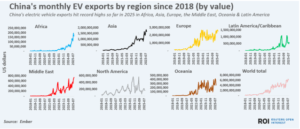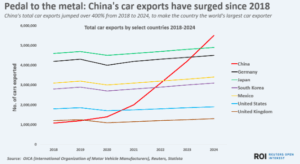Key Takeaways
China is the world’s leading exporter of automobiles, having mastered the electric vehicle (EV) market by producing inexpensive EVs with new models quicker than its competitors.
Low energy prices, cheap labor, dominance in the rare earth and battery markets, and government subsidies have helped China expand its EV market at home and abroad.
Due to its vast number of auto manufacturers and glut of EVs, China’s policymakers have opted to cut subsidies and state support for the EV sector in its upcoming five-year plan, which sets the industrial agenda from 2026 to 2030.
During the first nine months of 2025, EVs and hybrids made up almost half of all new car sales in China, helping the country reduce gasoline consumption and oil imports.
Wider EV adoption, as evidenced by the lower holiday gasoline demand, is cutting into Chinese oil demand and its oil imports, which could eventually change its role in the global market.
China is the world’s leading car exporter, with exports of Chinese electric vehicles scaling record highs in almost every continent so far this year. The top export markets for Chinese vehicles from January to September 2025 have been Mexico, the United Arab Emirates, Russia, Belgium, the United Kingdom, Saudi Arabia, Australia, Brazil, the Philippines, and Kazakhstan. According to the Associated Press, BYD – one of China’s largest EV makers — indicated that the United Kingdom has become its largest market outside China as its sales there increased 880% year-on-year in September. Via Reuters, Africa has been the fastest-growing region for Chinese EV imports so far in 2025, with a 184% increase in imports compared to 2024, to more than $1 billion in sales. The wide reach in China’s EV exports shows how well connected the sector is around the world, despite being a relatively new participant in the global car export market.

China had, in fact, overtaken Japan as the world’s leading car exporter in 2023. China’s export auto growth exploded after the COVID pandemic, as subsidies, cheap labor, and energy, and dominance in the rare earth and battery market allowed it to make inexpensive electric vehicles for domestic use and export. China boasts numerous EV manufacturers and is now considering lowering subsidies, which is expected to trigger a downsizing in EV manufacturers in China that could eventually lead to lower EV exports from the country. According to Reuters, China’s policymakers have opted to cut subsidies and state support for the EV sector in its upcoming five-year plan, which sets the industrial agenda from 2026 to 2030.

As reported by the Associated Press, China’s EV makers have been increasingly looking abroad to markets such as Europe and Southeast Asia as overcapacity and price wars back home have pressured their profit margins. They invested more abroad than inside China last year, for the first time since 2014.
The Domestic Market
Reuters reports that during the first nine months of this year, EVs and hybrids made up almost half of all new car sales in China. With the advent of EV use, gasoline consumption in China — the world’s biggest importer of oil — peaked in 2023, and demand is expected to decline by more than 4% this year from 2024 levels. Since China does not have the oil and gas resources of the United States, the transition to electric vehicles makes perfect sense for the country.
Via Reuters, China’s rapid build-out of charging infrastructure has reshaped holiday travel patterns, prompting tens of millions of people to take electric vehicles on the road during Golden Week, upending the usual surge in gasoline demand. Of the 63.5 million car trips logged over the eight-day break, about one in five were made in electric or hybrid cars. As a result, China’s October gasoline consumption fell an estimated 9% year-on-year to 12.5 million tons, with daily use roughly unchanged from September. Meanwhile, electricity consumption at charging stations — a key gauge of EV activity — jumped 45.7% during this year’s Golden Week compared with 2024.
How China Gained Dominance of the EV Market
China’s auto industry is pulling ahead of global rivals thanks largely to its speed. Chinese manufacturers can move a new model from concept to production in about 18 months — far faster than the roughly 5.4 years it takes many foreign automakers. That agility dramatically reduces development costs, allowing companies to roll out newer models at lower prices.
Much of the efficiency comes from China’s extensive use of standardized platforms and components across multiple vehicle lines, a level of consolidation many international brands have yet to match. While global automakers emphasize rigorous testing and precision manufacturing, Chinese firms often prioritize fast deployment, leaning heavily on digital simulations and artificial intelligence instead of lengthy physical testing.
The result is an industry with an enormous number of players and an oversupply of vehicles, many of which are now being pushed onto global markets. The glut is so large that some Chinese companies are selling brand-new, zero-mileage cars as used vehicles at steep discounts. China’s factories can now churn out 54 million vehicles a year — nearly double last year’s total of 27.5 million.
Analysis
China’s production capability has resulted in a relatively rapid acquisition of a significant market share of the global EV market. The industry is producing so many vehicles that they’re willing to sell them at low prices just to get rid of them, highlighting the market distortions that result from subsidizing products to such a degree that producers end up with surplus units that consumers don’t want. We have seen the same dynamic in the U.S., as the One Big Beautiful Bill’s termination of EV tax credits has contributed to automakers scaling back their production plans. Because subsidies entail opportunity costs, China’s dominance of the auto industry will have negative effects on other parts of its economy.
For inquiries, please contact [email protected].



